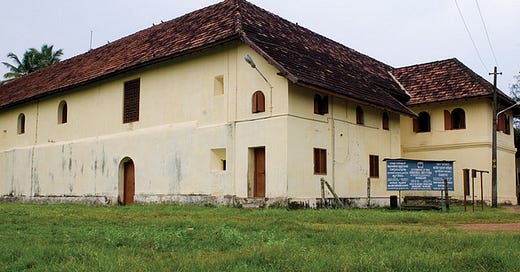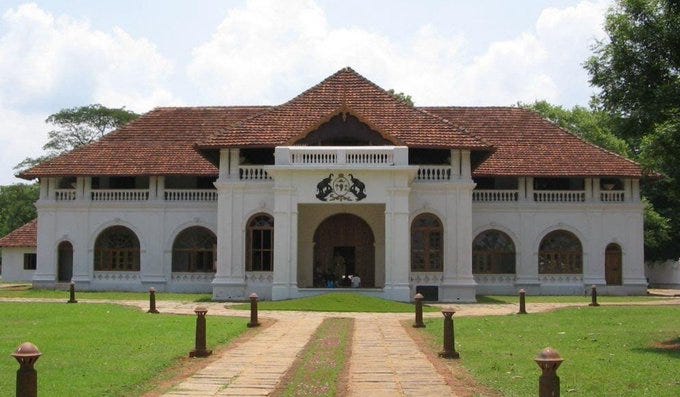The princely states of Travancore and Cochin, each with deep-rooted cultural and administrative traditions, merged to form the State of Travancore-Cochin, often informally called Thiru-Kochi. This was part of a broader national integration effort after independence.
With the implementation of the States Reorganisation Act based on linguistic lines, Malabar district (then part of Madras Presidency) was united with Travancore-Cochin. However, the southern part of Travancore (like Kanyakumari) was merged with Tamil Nadu, reflecting the Tamil linguistic identity of that region.
This union gave birth to the modern state of Kerala.
Travancore History
When Marthanda Varma inherited Venad in 1723, the region was fractured and plagued by local chieftains (Ettuveetil Pillamar). Through calculated political maneuvers and military campaigns, he centralized power, laying the foundation for what became the Kingdom of Travancore.
One of the defining moments of his reign, the Battle of Colachel marked the first major Asian victory over a European colonial power( Dutch).
Marthanda Varma’s most profound gesture came when he dedicated his kingdom to Lord Padmanabha (Vishnu), declaring himself merely a servant or Dasan.
His legacy isn't limited to military might; it includes administrative reforms, temple renovations, and a strong commitment to dharma. He laid the cultural and political foundations upon which Travancore flourished well into the 20th century.
Under Chithira Thirunal Balarama Varma, Travancore became one of the most progressive princely states in India, especially in education, public works, social reforms.
Ascending the throne in 1931 as the last ruling Maharaja of Travancore, he inherited a legacy of administrative sophistication — and elevated it with bold reforms. Though young, he governed with the intellect and foresight of a seasoned statesman, supported by brilliant Dewans like C. P. Ramaswami Iyer.
He pioneered free and compulsory education, a rare feature in princely India at the time. Encouraged women's education and access to higher learning across castes and classes. Established institutions like the University of Travancore (now University of Kerala) to foster academic excellence.
Infrastructure blossomed under his reign: roads, bridges, water supply systems, and electrification reached even remote areas. Major irrigation and dam projects boosted agriculture and rural livelihoods. Public health initiatives, including expanded hospitals and sanitation schemes, set benchmarks for other princely states.
Also issued the Temple Entry Proclamation in 1936 that allowed untouchables access to Hindu temples. Promoted inter-caste dining, women’s rights, and legal protections for marginalized communities.
Kochi History
Not as powerful as Travancore, kingdom of Cochin, primarily covered Kochi, Palakkad and Thrissur. Its original name, Perumpadappu Swarupam, reflects both its lineage and its socio-political identity under the Later Chera dynasty. The royal house hailed from the village of Perumpadappu in present-day Malappuram district — a name that quietly echoes through the centuries.
Though initially a feudal vassal of the Cheras, Kochi gradually asserted its autonomy as their influence waned. The Zamorin of Calicut, aggressively expansionist, repeatedly attacked and encroached upon Kochi’s territory. In response, Kochi turned to foreign alliances — first with the Portuguese in 1500s, later with the Dutch in the 1600s — each time trading short-term military aid for long-term colonial entanglement.
It became a pivot of European ambitions, often caught in the chessboard of colonial trade, especially with its strategic port at Kochi. These interactions turned Cochin into a melting pot where Malayali, Arab, Portuguese, Dutch, and even Jewish influences coexisted.
Kochi may not have wielded the military dominance of Travancore or the commercial might of Kozhikode, but it excelled in diplomatic agility, surviving through centuries of turbulence. Even under British rule , it maintained a princely identity, reforming education and administration in later years.
Kochi is famous for the Mattanchery Palace, built by Veera Kerala Varma, believed to be it's first Maharaja too. Also known as the Dutch Palace, it was initially built by the Portuguese around 1555 as a gift to the Cochin royal family — a gesture of allegiance.
Veera Kerala Varma is traditionally credited with commissioning or embellishing the structure, aligning it with Kochi’s rising assertion of sovereignty amid European entanglements.
The palace uniquely fuses Kerala’s nalukettu-style architecture (wooden ceilings, sloped roofs, central courtyard) with European influences — symbolizing the cultural mix of Kochi.
From the coronation hall (Poomukham) to the inner sanctums, every beam and mural carries stories of a kingdom balancing tradition with compromise.
Paravoor T. K. Narayana Pillai, was the first CM of Thiru-Kochi, and the last Prime Minister of Travancore state. Serving as Prime Minister (Dewan) during the final days of the Travancore monarchy, Pillai was a key architect in guiding the state toward integration with independent India.
With the formation of Travancore-Cochin (Thiru-Kochi) in 1949, he became its first Chief Minister, carrying forward the administrative legacy into a newly democratic framework. A stalwart of the Indian National Congress, his leadership helped navigate early tensions between the princely past and the parliamentary future.
In the first legislative elections held in 1951 under the democratic constitution of Thiru-Kochi, A. J. John, Anaparambil, an earnest Christian leader and social reformer, emerged as Chief Minister. His tenure marked a broadening of the political base, with increased representation for minorities and lower classes.
As part of India’s integration of princely states, the post of Rajpramukh was instituted — a constitutional position akin to that of a Governor, reserved for former monarchs in recognition of their accession.
Chithira Thirunal Balarama Varma, the Maharaja of Travancore, was appointed the Rajpramukh of Travancore-Cochin in 1949 and held the title until the position was abolished by the States Reorganisation Act in 1956.
The Maharaja of Cochin, equally esteemed, was offered the post of Uparajpramukh (Deputy Governor). But in a telling gesture, he declined the honor, saying he had no desire for additional titles.
When the princely states of Travancore and Cochin merged in 1949, the resulting state was organized into four main districts.
Thiruvananthapuram- The capital of Travancore and later Thiru-Kochi. A hub of intellectual and spiritual gravitas, crowned by the Padmanabhaswamy Temple and legacy of enlightened rulers.
Kollam-One of the oldest port cities on the Arabian coast, with roots in ancient Roman and Chinese trade.
Kottayam-Known for being Kerala’s literary cradle, with institutions like Malayala Manorama and a strong Syrian Christian presence. Played a prominent role in the Library Movement and grassroots education reforms.
Thrissur-The cultural heartland of Thiru-Kochi. Home to iconic institutions like the Vadakkunnathan Temple and Paradesi Synagogue, and festivals like Thrissur Pooram.
The 2nd CM of Thiru-Kochi state was C.Kesavan, who had taken part in the freedom struggle, and was an active member of the Travancore State Congress.
Born into the backward Ezhava community, his rise represented both personal triumph and a broader assertion of social justice.A lawyer by profession, he became a vehement critic of feudal autocracy, rallying under the Travancore State Congress banner to demand responsible governance.
His 1935 speech at Paravoor, denouncing the monarchy’s injustices and caste oppression, was so fiery it got him imprisoned. He embodied the ferment of Kerala’s early social movements, aligning with the Sree Narayana Dharma Paripalana (SNDP) movement while also drawing from Gandhian ideals.
As the second CM he led a coalition that sought to deepen democratic institutions while pushing forward progressive reforms.Later in life, Kesavan documented his journey in his memoir Jeevitha Smaranakal — offering glimpses into Kerala’s societal metamorphosis from within.
Pattom Thanu Pillai served as CM of Thiru-Kochi state from 1954-55, representing the Praja Socialist Party, he was a seasoned freedom fighter and jurist, deeply committed to democratic socialism and administrative integrity.
His leadership came at a tense juncture: the push for linguistic reorganization was intensifying, and regional identities were being vigorously asserted across India.
The Travancore Tamil Nadu Congress, founded to represent the interests of the Tamil-speaking population in southern Travancore, intensified its demand to merge Tamil-majority taluks like Nagercoil, Agastheeswaram, Thovalai, and Vilavancode with the Madras State (now Tamil Nadu).
Their agitation sprang from cultural-linguistic grievances and perceived discrimination in education, employment, and representation under a predominantly Malayalam-speaking administration.
As Chief Minister, he had to balance the concerns of the Malayalam-speaking majority with the grievances of the Tamil-speaking minorities — while also upholding the broader vision of a united state.
Panampilly Govinda Menon was the last CM of Thiru-Kochi state, after which it was merged with Malabar on Nov 1, 1956 to form Kerala State. A barrister, freedom fighter, and Congress leader, was known for his elegant oratory and deep legal acumen, he was deeply involved in nationalistic activism from his youth — even jailed for participating in the Salt Satyagraha.
During his brief but symbolic tenure, Menon had the delicate task of guiding the state through administrative reconfiguration in preparation for the reorganization of Indian states. He remained graceful in transition, ensuring the state’s machinery merged smoothly into the new Kerala framework.
November 1, 1956
Travancore-Cochin and the Malabar district of the erstwhile Madras State were unified under the States Reorganisation Act. The Tamil-speaking southern taluks of Travancore — including Kanyakumari — were transferred to Madras State (Tamil Nadu), honoring linguistic identities, creating the modern state of Kerala.










